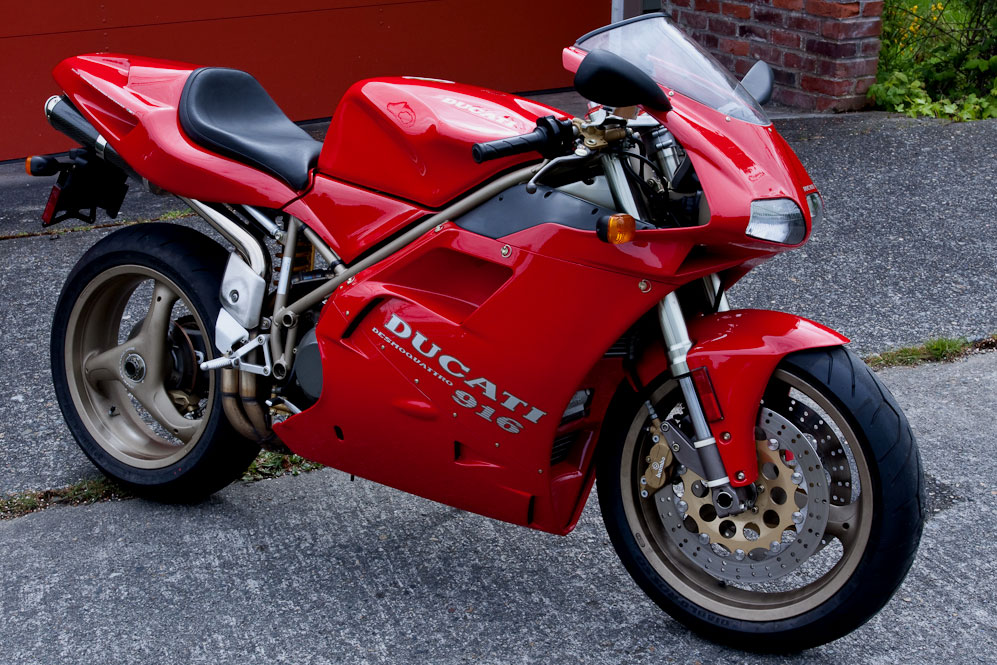The Ducati 916 is a sport bike motorcycle made by Ducati from 1994 to 1998.
In contrast to Japanese inline four-cylinder competitors of the time, its V-twin engine produced less outright power, but a more even torque spread.

The SPS was released to homologate the new 996cc engine for Superbike competition. The previous 916 crankcases had been maxed out at 955cc, and had problems with cracking and stress fractures under racing conditions. New reinforced crankcases were needed, and to accommodate a displacement closer to the 1000cc limit for twins in Superbike the case mouths needed wider openings and wider stud spacing to match. Thus the barrels and heads were new, made wider to match the new cylinder stud spacing. Bore was now up to 98mm, with the same 66mm stroke as before. The heads had larger combustion chambers and bigger valves. Compression ratio was now 11.5:1. Inside you a lighter crankshaft with tungsten plug balancing. The high-pressure double injector fuel setup with P8 ECU was carried over from the SP.
A new set of camshafts was introduced, using principles learned from racing Desmoquattros. They had nearly the same lift as the G inlet cam (and more than the A exhaust cam) but with much shorter duration. The new motor retained the frantic, free revving character of the 916 and SP, but with a stout midrange punch. They were still high lift cams in the end, though, and low speed running, idling, and clean emissions were not the motor’s forte. Especially when you factor in the much lighter internal parts and their momentum. Lighter crank and rods makes for a motor that spins easily and builds revs faster, but with the lessened flywheel effect it won’t idle particularly well. Ducati initially claimed the SPS made 134hp (with the “illegal” pipes that came with it), then later revised it to 123

Ducati 916 Strada
The 916 was “one of the most influential machines of the last twenty years”, the design is actually derivative of the Honda NR750, with the shared elements of underseat exhaust, narrow waist, similar squared-off dual headlights, and single-sided swingarm holding a large-section rear tire.
Ducati won 4 Superbike World Championships with the 916, in 1994–1996, and in 1998, with riders Carl Fogarty and Troy Corser. Fogarty won again in 1999, with 996 replacing the 916, and again in 2001 with Troy Bayliss on the 996. Ducati won the Manufacturer’s Championship in all those years plus 2000.
On March 1 and 2 in 1999, at the AHRMA Classic Days at Daytona International Speedway, Devin Battley rode a 1998 Ducati 916 to two victories. First, in the eight-lap Formula One class, and then in the Battle of the Twins Open class.
General characteristics
Engine: 916 cc (56 cu in), L-twin, fuel injected 4-valve-per-cylinder desmodromic, liquid-cooled
Top speed: 257 km/h (159.7 mph) or 260 km/h (161.6 mph)
Power: 85 kW (114 bhp) @ 9000 rpm
Transmission: 6-speed, chain drive
Frame type: Tubular steel trellis frame
Suspension Front: 43 mm (1.7 in) Showa
Rear: Showa rising-rate mono swingarm (US and Senna had Öhlins)
Brakes Front: Dual 320 mm (13 in)] disc
Rear: Single 220 mm (8.7 in) disc
Wheelbase: 1,410 mm (56 in)
Dimensions L: 2,050 mm (81 in)
W: 685 mm (27.0 in)
Seat height: 790 mm (31 in)
Weight: 194.5 kg (429 lb) (dry)
Share this:
- Click to share on Facebook (Opens in new window)
- Click to share on Twitter (Opens in new window)
- Click to print (Opens in new window)
- Click to share on LinkedIn (Opens in new window)
- Click to share on Reddit (Opens in new window)
- Click to share on Tumblr (Opens in new window)
- Click to share on Pinterest (Opens in new window)
- Click to share on Pocket (Opens in new window)
- Click to share on Telegram (Opens in new window)
- Click to share on WhatsApp (Opens in new window)




